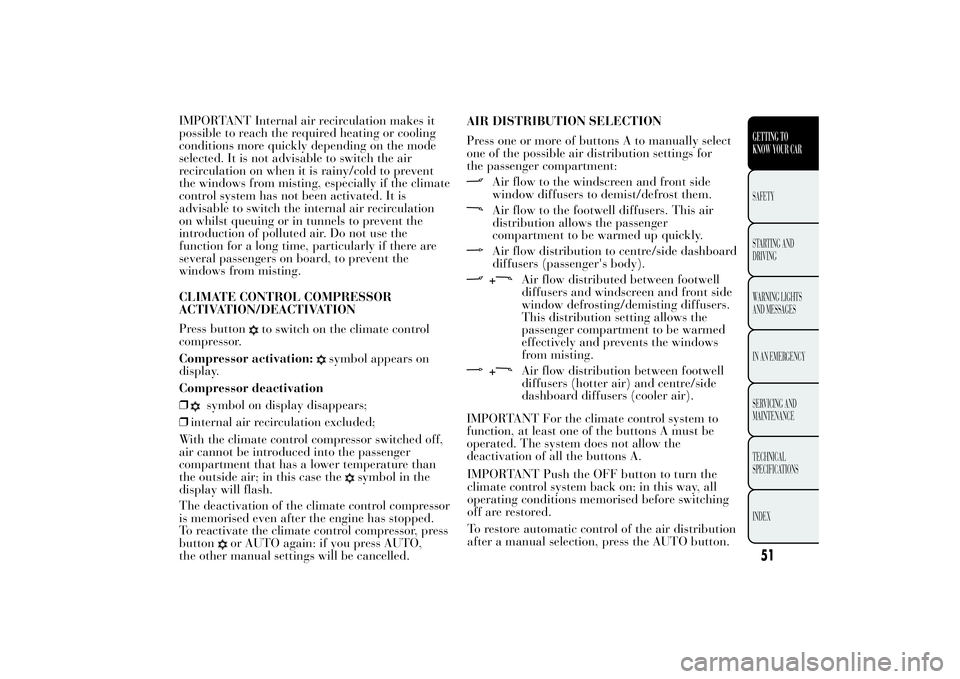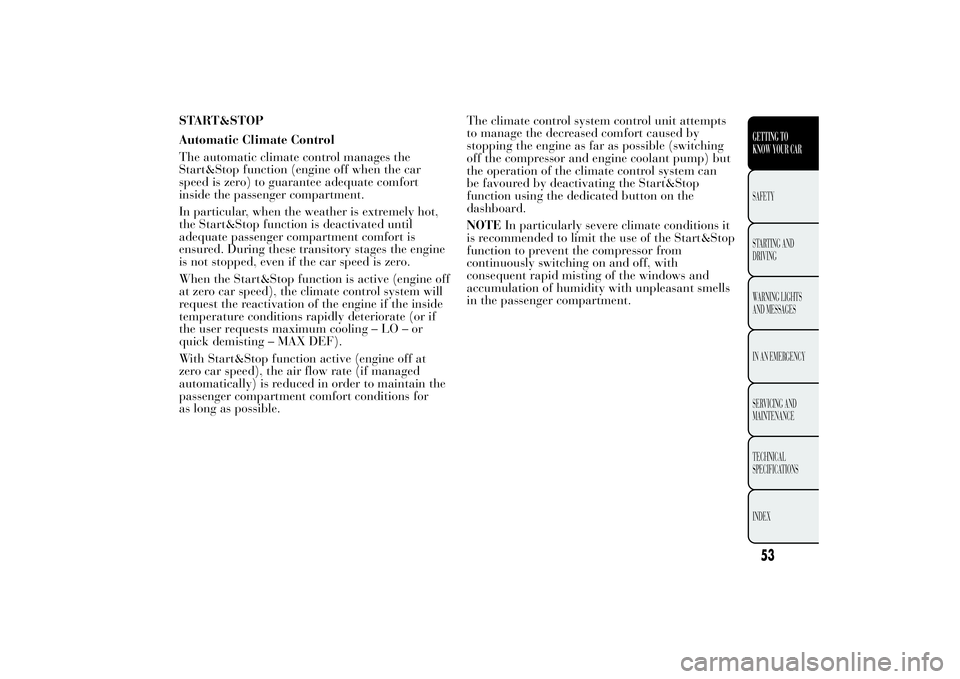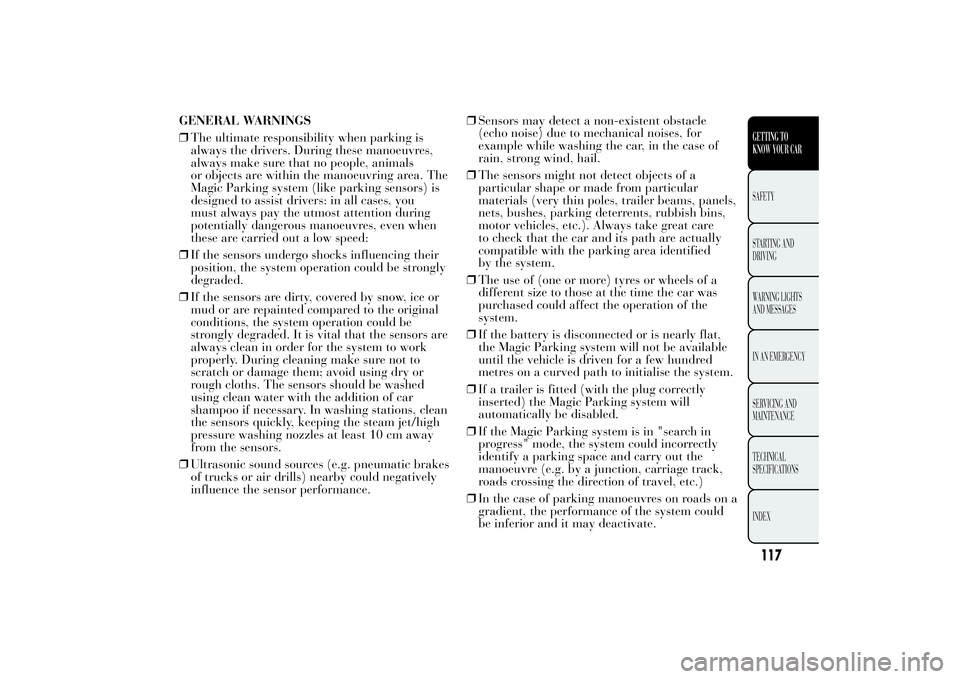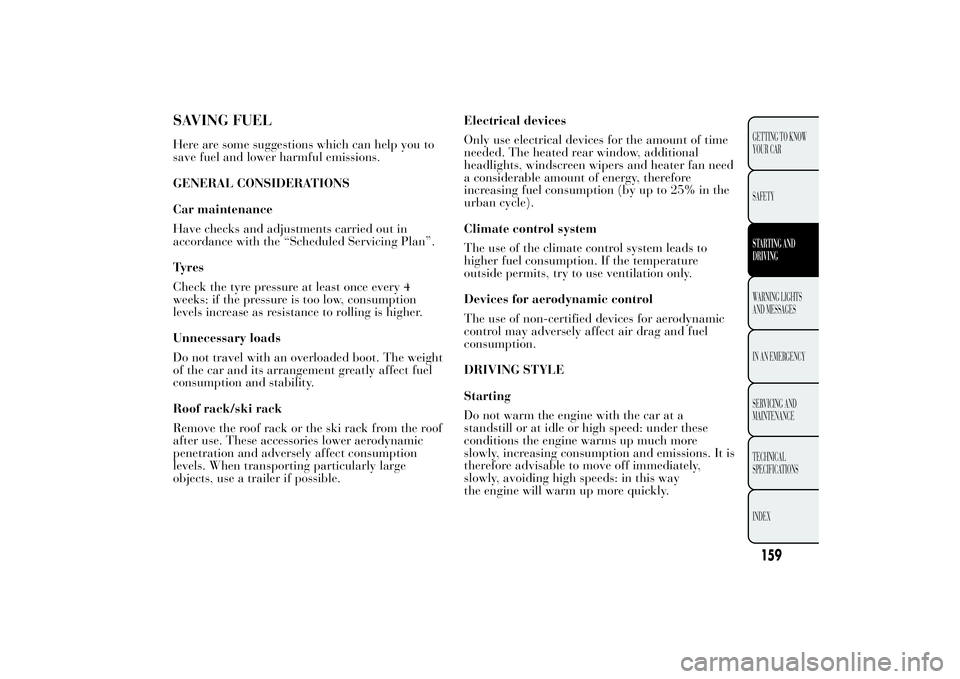air condition Lancia Ypsilon 2014 Owner handbook (in English)
[x] Cancel search | Manufacturer: LANCIA, Model Year: 2014, Model line: Ypsilon, Model: Lancia Ypsilon 2014Pages: 315, PDF Size: 13.18 MB
Page 48 of 315

Fast windscreen and front side window
demisting/defrosting (MAX-DEF)
Proceed as follows:
❒turn knob A to the red section;
❒move slider B to
;
❒turn knob C to
;
❒turn knob E to 4 (maximum fan speed).
IMPORTANT The climate control system is very
useful for speeding up demisting since it
dehumidifies the air. Adjust the controls as
described above and press button
to activate the
climate control system (the LED on the button
will light up).ADDITIONAL HEATER
(for versions/markets, where provided)
This device speeds up passenger compartment
warming when it is very cold. The additional
heater turns off automatically after reaching the
required comfort conditions.
The heater activates automatically when knob A is
turned to the last red section and the fan is
activated (knob E turned to at least 1
stspeed).
The heater only works if the outside temperature
and engine coolant temperature are low. The
heater will not activate if the battery voltage is too
low.
SYSTEM MAINTENANCE
In winter, the climate control system must be
turned on at least once a month for about
10 minutes. Have the system inspected at a
Lancia Dealership before the summer.
44GETTING TO
KNOW YOUR CAR
SAFETY
STARTING AND
DRIVING
WARNING LIGHTS
AND MESSAGES
IN AN EMERGENCY
SERVICING AND
MAINTENANCE
TECHNICAL
SPECIFICATIONS
INDEX
Page 50 of 315

towards the front seat feet area diffusers. Due
to the natural tendency of heat to rise, this
type of distribution warms the passenger
compartment up as quickly as possible,
providing an immediate feeling of warmth.+
distribution between feet area diffusers
(warmest air) and dashboard vents
(coolest air).
+
distribution between feet area diffusers
and windscreen/front side window
diffusers. This type of distribution
achieves effective heating of the
passenger compartment and prevents
the windows from misting up.
Button B MAX
- MAX-DEF function
activation
When theMAXbutton
is pressed, the system
activates all the functions required for fast
demisting/defrosting, that is:
❒compressor on (if the weather conditions are
suitable)
❒air recirculation off
❒maximum air temperature setting (HI)
❒fan speed determined according to the coolant
temperature
❒air flow conveyed to the windscreen and front
side windows❒Button C
- Climate control compressor
activation/deactivation
When the
symbol is lit on the display, press
button C to switch off the compressor.
When the compressor is deactivated:
❒the system will deactivate air recirculation to
prevent the windows from misting up;
❒it is not possible to convey air to the passenger
compartment with a temperature below the
outside temperature (the temperature indicated
on the display will flash when the system cannot
guarantee the required comfort conditions);
❒the fan speed can be manually reset (with
compressor enabled, ventilation cannot go
below a bar shown on the display).
46GETTING TO
KNOW YOUR CAR
SAFETY
STARTING AND
DRIVING
WARNING LIGHTS
AND MESSAGES
IN AN EMERGENCY
SERVICING AND
MAINTENANCE
TECHNICAL
SPECIFICATIONS
INDEX
Page 51 of 315

Button D
- Internal air recirculation
on/off
It is advisable to switch the internal air
recirculation on whilst queuing or in tunnels to
prevent the introduction of polluted air.
At low temperatures or if the compressor is off,
the recirculation is forced to off to prevent
misting.
IMPORTANT It is inadvisable to use air
recirculation when the outside temperature is low,
since the windows could mist rapidly.
Button E (AUTO) - AUTO function activation
(automatic climate control operation)
When the AUTO button is pressed and the
required temperature is set, the system adjusts air
temperature, quantity and distribution into the
passenger compartment and manages the
activation of the compressor.
Button F
- Heated rear window activation/
deactivation
When button
is pressed, the LED on the button
switches on.Buttons G
- Fan speed adjustment
Button H (OFF) - Climate control activation/
deactivation
When the OFF button is pressed, the system is
deactivated.
With the system off, the climate control system
conditions are as follows:
❒all LEDs are off;
❒set temperature display is off;
❒air recirculation is off;
❒compressor is off;
❒fan is off.
Button I - Air temperature increase
When the button is pressed, the passenger
compartment air temperature increases.
Button L - Air temperature decrease
When the button is pressed, the passenger
compartment air temperature decreases.
47GETTING TO
KNOW YOUR CARSAFETY
STARTING AND
DRIVING
WARNING LIGHTS
AND MESSAGES
IN AN EMERGENCY
SERVICING AND
MAINTENANCE
TECHNICAL
SPECIFICATIONS
INDEX
Page 52 of 315

DESCRIPTION
The automatically controlled parameters and
functions are:
❒air temperature at the vents;
❒air distribution at the vents;
❒fan speed (continuous variation of the air flow)
❒compressor activation (for cooling/
dehumidifying the air)
❒air recirculation.
All functions may be changed manually. In other
words, you may select one or more functions
and change the parameters as required. Automatic
control of the manually changed functions will
be suspended: the system will only override your
settings for safety-related reasons (e.g. risk of
misting).
Manual selections always have higher priority over
automatic settings and are stored until the user
switches the system back to automatic control
expect for cases in which the system intervenes for
particular safety-related reasons. You can adjust
one function manually without affecting the
automatic control of the others.
The amount of air introduced into the passenger
compartment is not affected by car speed; it is
regulated by the fan, which is controlled
electronically.The temperature of the air introduced is always
controlled automatically, according to the
temperature set in the display for the driver and
the front passenger (except when the system is off
or in certain conditions when the compressor is
deactivated).
The system allows the following to be set or
adjusted manually:
❒air temperature;
❒fan speed (continuous variation)
❒air distribution with 5 positions;
❒compressor activation
❒single zone/dual zone distribution priority
❒rapid defrosting/demisting function
❒air recirculation
❒heated rear window
❒system deactivation.
48GETTING TO
KNOW YOUR CAR
SAFETY
STARTING AND
DRIVING
WARNING LIGHTS
AND MESSAGES
IN AN EMERGENCY
SERVICING AND
MAINTENANCE
TECHNICAL
SPECIFICATIONS
INDEX
Page 55 of 315

IMPORTANT Internal air recirculation makes it
possible to reach the required heating or cooling
conditions more quickly depending on the mode
selected. It is not advisable to switch the air
recirculation on when it is rainy/cold to prevent
the windows from misting, especially if the climate
control system has not been activated. It is
advisable to switch the internal air recirculation
on whilst queuing or in tunnels to prevent the
introduction of polluted air. Do not use the
function for a long time, particularly if there are
several passengers on board, to prevent the
windows from misting.
CLIMATE CONTROL COMPRESSOR
ACTIVATION/DEACTIVATION
Press button
to switch on the climate control
compressor.
Compressor activation:
symbol appears on
display.
Compressor deactivation
❒
symbol on display disappears;
❒internal air recirculation excluded;
With the climate control compressor switched off,
air cannot be introduced into the passenger
compartment that has a lower temperature than
the outside air; in this case the
symbol in the
display will flash.
The deactivation of the climate control compressor
is memorised even after the engine has stopped.
To reactivate the climate control compressor, press
button
or AUTO again: if you press AUTO,
the other manual settings will be cancelled.AIR DISTRIBUTION SELECTION
Press one or more of buttons A to manually select
one of the possible air distribution settings for
the passenger compartment:
Air flow to the windscreen and front side
window diffusers to demist/defrost them.Air flow to the footwell diffusers. This air
distribution allows the passenger
compartment to be warmed up quickly.Air flow distribution to centre/side dashboard
diffusers (passenger's body).+
Air flow distributed between footwell
diffusers and windscreen and front side
window defrosting/demisting diffusers.
This distribution setting allows the
passenger compartment to be warmed
effectively and prevents the windows
from misting.
+
Air flow distribution between footwell
diffusers (hotter air) and centre/side
dashboard diffusers (cooler air).
IMPORTANT For the climate control system to
function, at least one of the buttons A must be
operated. The system does not allow the
deactivation of all the buttons A.
51GETTING TO
KNOW YOUR CARSAFETY
STARTING AND
DRIVING
WARNING LIGHTS
AND MESSAGES
IN AN EMERGENCY
SERVICING AND
MAINTENANCE
TECHNICAL
SPECIFICATIONS
INDEX
IMPORTANT Push the OFF button to turn the
climate control system back on: in this way, all
operating conditions memorised before switching
off are restored.
To restore automatic control of the air distribution
after a manual selection, press the AUTO button.
Page 56 of 315

SWITCHING OFF THE CLIMATE CONTROL
SYSTEM
Press the OFF button.
The following information is shown on the
display:
❒OFF
❒internal air recirculation active indication.
SYSTEM MAINTENANCE
In winter, the climate control system must be
turned on at least once a month for about
10 minutes.
Before summer, have the system checked at a
Lancia Dealership.
The system uses R134a refrigerant
fluid which does not pollute the
environment in the event of accidental
leakage. Never use R12 fluid, which is not
compatible with the system components.ADDITIONAL HEATER
(for versions/markets, where provided)
This allows the passenger compartment to be
heated more quickly in cold weather conditions.
The heater switches on automatically according to
the environmental conditions and with engine
started when the temperature of the engine
coolant is low.
The heater switches off automatically when the
required comfort conditions are achieved.
The heater only operates if the outside
temperature and engine coolant temperature are
low. The heater will not activate if the battery
voltage is too low.
52GETTING TO
KNOW YOUR CAR
SAFETY
STARTING AND
DRIVING
WARNING LIGHTS
AND MESSAGES
IN AN EMERGENCY
SERVICING AND
MAINTENANCE
TECHNICAL
SPECIFICATIONS
INDEX
Page 57 of 315

START&STOP
Automatic Climate Control
The automatic climate control manages the
Start&Stop function (engine off when the car
speed is zero) to guarantee adequate comfort
inside the passenger compartment.
In particular, when the weather is extremely hot,
the Start&Stop function is deactivated until
adequate passenger compartment comfort is
ensured. During these transitory stages the engine
is not stopped, even if the car speed is zero.
When the Start&Stop function is active (engine off
at zero car speed), the climate control system will
request the reactivation of the engine if the inside
temperature conditions rapidly deteriorate (or if
the user requests maximum cooling – LO – or
quick demisting – MAX DEF).
With Start&Stop function active (engine off at
zero car speed), the air flow rate (if managed
automatically) is reduced in order to maintain the
passenger compartment comfort conditions for
as long as possible.The climate control system control unit attempts
to manage the decreased comfort caused by
stopping the engine as far as possible (switching
off the compressor and engine coolant pump) but
the operation of the climate control system can
be favoured by deactivating the Start&Stop
function using the dedicated button on the
dashboard.
NOTEIn particularly severe climate conditions it
is recommended to limit the use of the Start&Stop
function to prevent the compressor from
continuously switching on and off, with
consequent rapid misting of the windows and
accumulation of humidity with unpleasant smells
in the passenger compartment.
53GETTING TO
KNOW YOUR CARSAFETY
STARTING AND
DRIVING
WARNING LIGHTS
AND MESSAGES
IN AN EMERGENCY
SERVICING AND
MAINTENANCE
TECHNICAL
SPECIFICATIONS
INDEX
Page 121 of 315

GENERAL WARNINGS
❒The ultimate responsibility when parking is
always the drivers. During these manoeuvres,
always make sure that no people, animals
or objects are within the manoeuvring area. The
Magic Parking system (like parking sensors) is
designed to assist drivers: in all cases, you
must always pay the utmost attention during
potentially dangerous manoeuvres, even when
these are carried out a low speed:
❒If the sensors undergo shocks influencing their
position, the system operation could be strongly
degraded.
❒If the sensors are dirty, covered by snow, ice or
mud or are repainted compared to the original
conditions, the system operation could be
strongly degraded. It is vital that the sensors are
always clean in order for the system to work
properly. During cleaning make sure not to
scratch or damage them; avoid using dry or
rough cloths. The sensors should be washed
using clean water with the addition of car
shampoo if necessary. In washing stations, clean
the sensors quickly, keeping the steam jet/high
pressure washing nozzles at least 10 cm away
from the sensors.
❒Ultrasonic sound sources (e.g. pneumatic brakes
of trucks or air drills) nearby could negatively
influence the sensor performance.❒Sensors may detect a non-existent obstacle
(echo noise) due to mechanical noises, for
example while washing the car, in the case of
rain, strong wind, hail.
❒The sensors might not detect objects of a
particular shape or made from particular
materials (very thin poles, trailer beams, panels,
nets, bushes, parking deterrents, rubbish bins,
motor vehicles, etc.). Always take great care
to check that the car and its path are actually
compatible with the parking area identified
by the system.
❒The use of (one or more) tyres or wheels of a
different size to those at the time the car was
purchased could affect the operation of the
system.
❒If the battery is disconnected or is nearly flat,
the Magic Parking system will not be available
until the vehicle is driven for a few hundred
metres on a curved path to initialise the system.
❒If a trailer is fitted (with the plug correctly
inserted) the Magic Parking system will
automatically be disabled.
❒If the Magic Parking system is in "search in
progress" mode, the system could incorrectly
identify a parking space and carry out the
manoeuvre (e.g. by a junction, carriage track,
roads crossing the direction of travel, etc.)
❒In the case of parking manoeuvres on roads on a
gradient, the performance of the system could
be inferior and it may deactivate.
117GETTING TO
KNOW YOUR CARSAFETY
STARTING AND
DRIVING
WARNING LIGHTS
AND MESSAGES
IN AN EMERGENCY
SERVICING AND
MAINTENANCE
TECHNICAL
SPECIFICATIONS
INDEX
Page 133 of 315

The regeneration procedure is controlled
automatically by the engine management control
unit according to the filter conditions and car
use conditions.
There may be a limited increase in the engine idle
speed during the regeneration, a limited increase
in fumes and high temperatures at the exhaust.
These are not faults; they do not impair normal
vehicle performance or damage the environment.
If the dedicated message is displayed, refer to
paragraph "Warning lights and messages".
WARNING
During normal service, the catalytic
converter and the diesel particulate
filter (DPF) reach high temperatures. Do not
therefore park the car over inflammable
materials (grass, dry leaves, pine needles,
etc.): fire hazard.
129GETTING TO
KNOW YOUR CARSAFETY
STARTING AND
DRIVING
WARNING LIGHTS
AND MESSAGES
IN AN EMERGENCY
SERVICING AND
MAINTENANCE
TECHNICAL
SPECIFICATIONS
INDEX
Page 163 of 315

Electrical devices
Only use electrical devices for the amount of time
needed. The heated rear window, additional
headlights, windscreen wipers and heater fan need
a considerable amount of energy, therefore
increasing fuel consumption (by up to 25% in the
urban cycle).
Climate control system
The use of the climate control system leads to
higher fuel consumption. If the temperature
outside permits, try to use ventilation only.
Devices for aerodynamic control
The use of non-certified devices for aerodynamic
control may adversely affect air drag and fuel
consumption.
DRIVING STYLE
Starting
Do not warm the engine with the car at a
standstill or at idle or high speed: under these
conditions the engine warms up much more
slowly, increasing consumption and emissions. It is
therefore advisable to move off immediately,
slowly, avoiding high speeds: in this way
the engine will warm up more quickly.
159GETTING TO KNOW
YOUR CAR
SAFETYSTARTING AND
DRIVINGWARNING LIGHTS
AND MESSAGES
IN AN EMERGENCY
SERVICING AND
MAINTENANCE
TECHNICAL
SPECIFICATIONS
INDEX
SAVING FUELHere are some suggestions which can help you to
save fuel and lower harmful emissions.
GENERAL CONSIDERATIONS
Car maintenance
Have checks and adjustments carried out in
accordance with the “Scheduled Servicing Plan”.
Tyres
Check the tyre pressure at least once every 4
weeks: if the pressure is too low, consumption
levels increase as resistance to rolling is higher.
Unnecessary loads
Do not travel with an overloaded boot. The weight
of the car and its arrangement greatly affect fuel
consumption and stability.
Roof rack/ski rack
Remove the roof rack or the ski rack from the roof
after use. These accessories lower aerodynamic
penetration and adversely affect consumption
levels. When transporting particularly large
objects, use a trailer if possible.